|
August 6, 2007 Cape York Peninsula
| Getting up early, we headed toward Cooktown, the last town before heading into the Cape York Peninsula. Along the way we stopped at the "famous" Lions Den Bar and Hotel. The bar is in a corrugated building with the walls covered with graffiti and it is a local institution as it has been in business since 1875. |
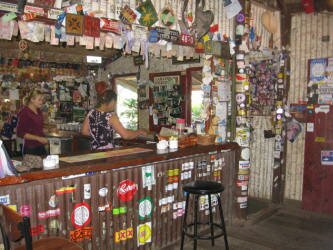
|
Continuing north, we crossed the Annan River and headed into Cooktown. Cooktown was where Captain James Cook had to beach his ship, the Endeavour, to make repairs after the ship ran onto a reef and was damaged. We visited all the important historical sites which included the statue of Cook himself, the cairn marking the spot where the ship was actually beached and the hill that Cook climbed to scout a way out past the reef without hitting it again. Our tour was actually quite interesting and the view from Grassy Hill out toward the reef was spectacular. And it made more apparent the fear that Cook wrote about in his journal: that there was no way back out. We also explored the town cemetery and viewed many of the tombstones that date back over one hundred years ago.
|
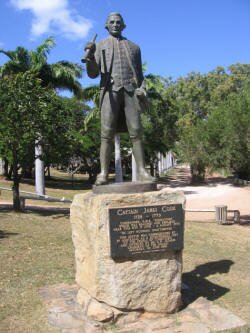
James Cook
|
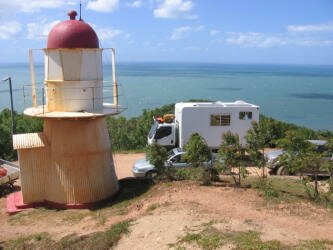
View overlooking the reef
|
After our tour of the historical sites, we went back into the town and ran some errands. We then asked one of the locals for a good spot to free camp. She directed us back to the Annan River where we found a beautiful, quiet spot to spend the night.
August 7, 2007
| Once again getting an early start, we hit the dirt road that starts the 700+kms to the top of the Cape York Peninsula. This road is one of the most famous 4wd road trips in Australia. Knowing the limits of our vehicle, we know that we won't be able to do the most difficult sections of the road (we'll have to take the bypass roads) but we are hoping to do as much as possible. We'll also have to keep our eyes open for road trains so that we can get out of their way so as to avoid getting hit by any flying gravel kicked up by their 50 tires. |
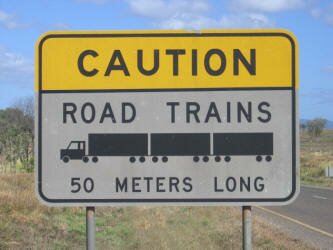
|
Our first stop was in the town of Laura where we got our first gas fill at $1.44au/liter which is $4.62us/gallon. Ouch, but we knew the fuel would be expensive in this part of the country (not that it has been cheap before this, we've been paying approx $1.22/liter which is $3.92/gallon). Our next stop was at the Split Rock Aboriginal Art site where we viewed beautiful rock art paintings that are anywhere from 8,000 to 14,000 years old. One of our favorites was an entire rock covered with pictures of flying foxes (bats) hanging upside down. This area is referred to as Quinkan Rock Art, named after the paintings of Aboriginal Spirits. UNESCO rates this region, there are hundreds of sites, as one of the top ten rock art areas in the world.
We continued along our way, stopping for a break at the Hann River Roadhouse. Continuing on we encountered our first rough corrugate (washboard) road. Even though this is considered a 4wd drive road, for the section that we were on that really only applies during the wet season. At this time of year, on this stretch of road, the demon is the corrugated bumps that threaten to shake a vehicle to pieces. General consensus has it that if you drive fast, you can skim over the top and avoid the worst bumping. That works sometimes, when the corrugate is small. But once the corrugate is big (at least in our vehicle) the only choice is to slow down, which is almost impossible to do without shaking the brain out of your head. We've even lowered the pressure in our tires to try and soften the ride.
Late in the day, we reached the turnoff for the Mary Valley Station. This is a cattle ranch that also allows camping. We chose this spot because they also have one of the world's largest colonies of Little Red Flying Foxes nearby. But even though our map and our Lonely Planet guide both said camping was available, we hesitated at the gate because there weren't any signs indicating that there was camping. Taking our chances (the station was 6km (3.5 mi) off the highway) we drove in. Finally finding some buildings we stopped and tried to find someone. After wandering around for a while, we finally found a ranch hand, Bill, who told us that yes, we could camp for $8.50au/night. Bill also told us that the flying foxes would actually rest in the trees right above our camp, cool.
The spot was beautiful, with lots of birds and wallabies. As night fell, we set up our chairs to wait for the flying foxes. Finally we saw one that landed in a tree and we were able to get a pretty good view of him before it got dark. As we settled back into our chairs, we started seeing more bats. And then we realized we could hear them from a long way off. There was a drone of chirping that sounded a lot like a flock of birds. First we could see a couple of flying foxes, then a couple more, then a dozen, then thousands. Then hundreds of thousands. There may have been a million, really! There were so many bats flying overhead we actually have no idea how many there were, it just reminded us a Alfred Hitchcock movie. As darkness fell, the bats came lower and lower and started roosting in the trees right above our heads. The sound was deafening, sounds of wings and squeaks and squawks. We were absolutely overwhelmed by the experience and it continued long after we went inside (which was after 1-1/2 hours). We could still hear them after we went to bed.
August 8 - 11, 2007
From Mary Valley Station we drove onwards. We stopped at Musgrave Roadhouse, checked the price of fuel ($1.49/liter) and then continued on to the town of Coen, which consists of just a couple of streets and a handful of businesses - two of which were fuel stations, which we needed to fill up our tank for the long ride north. We spent the night at "The Bend", a free campsite on a bend in the Coen River, just outside of town. As we have found, Aussies love their free campsites, so we were glad we stopped fairly early and got a nice flat spot, as several other cars pulled up after us and had to camp in the less than level spots.
|
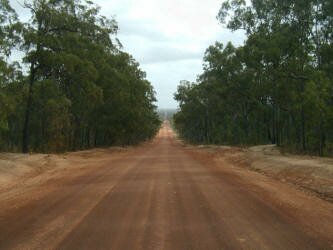
|
The next morning we continued north and the drive was through beautiful scenery. The Cape York Peninsula covers an area of approximately 150,000 square kilometers and our drive would take us through mostly dry savannah and eucalypt forests. This is the dry season so most of the streams and rivers are either dry or very low, and the roads are extremely dusty. |
We stopped for lunch at the Archer River Roadhouse and had the "famous" Archer Burger. This consisted of all the normal things you would put on a hamburger plus a fried egg, a slice of pineapple and slices of beet. It was too big to put in your mouth!
All throughout the Cape York Peninsula are termite mounds. Many are small and conical, like upside down ice-cream cones, while others look like fantasy castles or rockets.
| We spent the night across the Wenlock River from the old Moreton Telegraph Station, where we found an old lineman's hut and an old telegraph pole. We did an early morning walk along the Wenlock for bird watching and saw a flock of beautiful Rainbow Bee-eaters, but no crocs in the river despite the warning signs. Signs are everywhere but we've yet to see a crocodile. We did however, see a sign put up in a tree by some locals in a boat during a cyclone in 2003 when the water flooded over the bridge to a depth of 14.3 meters (46.5 feet)! It said "we were here in a boat in 2003...). |
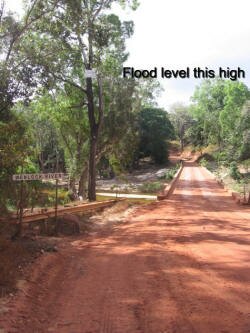
|
We attempted to travel north for a while along the Old Telegraph Track (OTT) but were stymied by how overgrown the trail was with trees crowding the track from the sides and crossing low over our heads. Forced to take the Bypass Road to the Jardine River, we found our worst section of corrugate road yet. How about driving at 10 mph for over two hours! The road was so bumpy that our toilet paper roll unraveled into a pile on the floor.
When we reached the northern section of the OTT we tried again to drive along it but had to turn around after only a mile due to the erosion at the water crossings that would put us on too much of a side to side angle. We once again returned to the Bypass Road, and upon reaching the Jardine River with its cable-ferry crossing, decided to take a break for the next two nights.
|
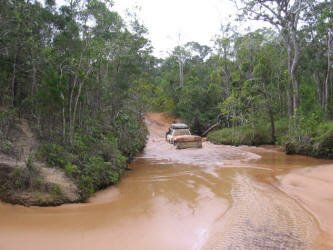
Old Telegraph Trail creek crossing
|
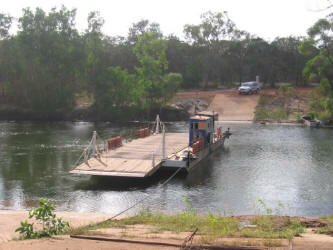
Jardine River ferry
|
August 12 - 16, 2007
We then traveled back over the horrible, corrugated road (only this time we knew what to expect) stopping for a third time to access the OTT and once again found a section where the side to side angle was too steep for us to continue. We continued on, returning to our Wenlock River campsite, glad to find that it was available and took our chairs and binoculars down to the water's edge to unwind after 7 hours of bumpy driving.
The next morning we took a 4wd shortcut across to the town of Weipa, which is the location of the largest bauxite deposit in the world and one of its largest mines. Bauxite is the raw material from which aluminum is processed. All along the road into town, we saw evidence of the mines. The bauxite is located only a meter or so below ground level and is so pure that it can be dug up and shipped directly out for processing. The next couple of days will likely be just driving days as we need to retrace our steps nearly all the way back down to Cairns. The round trip 4wd, corrugate, dirt drive will have taken us nearly 1,800 km (1,100 miles).
| In the morning, as much as we had thought that we would get an early start, we took our time before getting packed and on the road. Even then we drove into town to the library to use their internet connection, then on to the fuel station to fill our tank. By the time we actually got out of town, it was nearly 2:30pm. Oh well. The road out of town passes through a route that gives the huge mining vehicles right of way. While we were stopped, a giant earthmover rumbled by. |
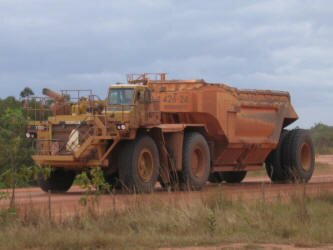
|
The road out of Weipa is quite good, and we figured it was because the mining company keeps it that way for its own trucks. The main road, however, had terrible stretches of corrugate and we had to keep slowing way down for the bad parts. We drove south towards the Archer River Roadhouse but decided to call it quits for the day at about 6:00pm and found a beautiful spot, off the road, alongside an unmarked side track that took us to a pond where there were lots of birds (kookaburras, cormorants, egrets, ducks, rainbow lorikeets, gulahs and one huge jabiru stork.) Every now and then, we find these incredible bush camps that make for a great end to the day.
We started our morning spending some time trying to stem some of the dust leakage into the storage compartments by adding additional weather stripping. Time will tell if we were successful. The dust issue is a big one for everyone who travels dirt roads for any length of time and we have had many a conversation regarding dust!
The next day was another long day of travel. Since we have already driven this stretch of road in the other direction, we have stopped at the various sights and now we are just moving along to get off of the peninsula. We made camp at the Musgrave Roadhouse, spending the evening talking with the other drivers who had passed us on the road (they all drive faster than we do). We have met many wonderful travelers in Australia. The majority of them have been Australian, but not all of them. But they have all had a love of being on the road and love to share information and stories. We have really enjoyed our nights in the campgrounds meeting these new people.
Leaving the roadhouse, last ones out of the gate as usual, we stopped to telephone the fridge repairman in Cairns. We defrosted our fridge in Weipa two days ago, and since then it hasn't been working right. So since we have to drive near Cairns anyway, we made an appointment to have him check it out.
About 1pm we reached the end of the dirt portion of the Peninsula Development Road! Since we passed this point on our way north nine days ago, we have driven over 1,000 miles - the longest distance traveled on dirt roads at one continuous time since we began the World of Wonders Project!
| About an hour later, the most amazing thing happened. We had been in contact with another overland couple that we met on the internet while they were in South America (we missed meeting each other in Peru by about three hours.) We had received an email from them two days ago wherein they indicated that they were in Australia driving north from Cairns. So here we are, both driving along and WOW, we pass each other on the road! So we both stopped and spent an hour on the side of the road talking about experiences. Unfortunately we were heading in opposite directions, so we compared routes and hope that we'll meet again somewhere down the road. |
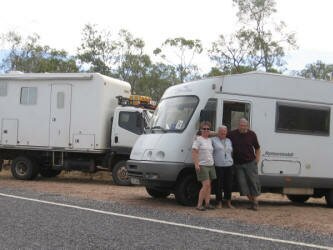
|
|